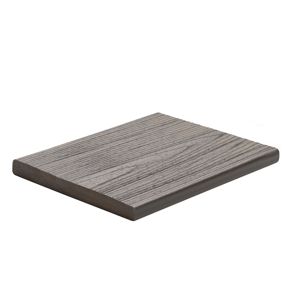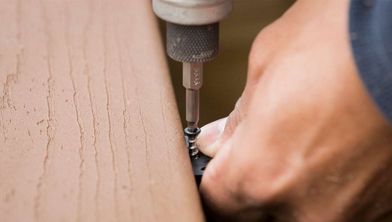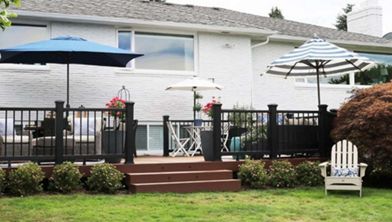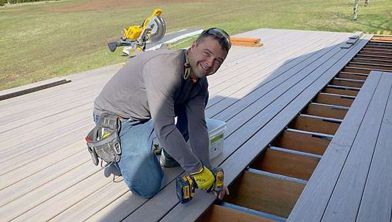What is a Fascia Board? Explore Our Complete Guide to Decking Fascia Boards.
Learn about what decking fascia is and why you should use it to give your deck a finished look.
Fascia boards are a key feature of a deck that adds aesthetic appeal and performs several practical functions. Understanding the purpose of a fascia board and how to choose the right one is vital when planning a deck project.
This article will explain what fascia boards are and why they’re important. Our Fascia Decking Photo Gallery has some useful images demonstrating how fascia boards work. We’ll also provide information about the different types of fascia board material available, including Trex® Composite Fascia Boards, so you can make an informed decision when adding fascia to your deck.
What is a Fascia Board?
A fascia board is a sheet of timber or composite material that fits around the border of your deck. Fascia hides the joists underneath the deck and gives you a polished look. Sometimes called a rim joist cover, a fascia board is primarily an aesthetic feature that also protects the joists and may cover the exposed ends of the deck boards.
Fascia boards are attached to the deck in a variety of ways, depending on how the deck is constructed. If the deck boards extend all the way to the edge with no perimeter board, the fascia board will cover the entire height of the deck, including the exposed ends of the boards.
However, if the deck has a perimeter board and a picture frame border, the fascia board sits underneath the deck surface. The perimeter board creates a slight lip, and the fascia board is attached underneath to cover the rim joists.
Small spacers can be used between the edge of the deck and the fascia boards. These ensure the boards are flush and allow for air flow. A slight gap allows water and dirt to drain and prevents them from building up between the fascia and the deck, reducing the chance of rotting. Once the spacers are attached to the edge of the deck, the fascia is screwed on top.
You can use coloured fasteners that match the decking material to attach your fascia boards to get a flush appearance. You can also use plugs to cover the holes so the fasteners are completely hidden.
These instructions are based on the guidelines for installing fascia on Trex decking. Our how-to article on installing deck fascia boards has up-to-date information to help you with your deck project. However, all fascia boards are slightly different, and the installation method may vary by manufacturer. Always check with the manufacturer for installation guidelines specific to your fascia product before you start. Deck fascia boards are usually made from the same material as the rest of the deck (timber or composite). You can use the same colour for a clean look or a different colour to create contrast. While fascia boards are not entirely necessary, they improve the look of your deck and give added protection to the joists.
Purpose of Fascia Boards
Protect Against Moisture
Fascia boards perform many functions. Most importantly, they stop water from getting underneath the decking and damaging the frame. Excess moisture causes rot, and eventually the deck’s structural integrity suffers. Using moisture-resistant finishes helps prevent rot, but a fascia can further extend the life of the deck.
Keep Pests Out
Fascia boards also create a barrier for pests like squirrels, birds, and mice, preventing them from getting under the deck. Without the fascia board to stop them, they can cause damage by chewing through the frame, leaving droppings that cause rot, and eating insulation. The underside of a deck is the perfect hiding spot for pests, and they can cause a lot of damage to the structure. Using a fascia board is the best way to keep them out.
Create A Seamless Look
Fascia boards give your deck a seamless look by covering the sides. They may be attached using coloured fasteners that match the fascia material. You can also hide the fasteners using a small plug of the same material so they’re completely invisible. Fascia boards with a fastener-free finish look much neater and cleaner than decking with an open gap along the sides.
Types of Fascia Boards
There are many types of fascia boards. Before installing new fascia boards on your deck, you need to decide which fascia material is best for your design. Below, we have outlined the pros and cons of the most common deck fascia materials: composite, timber, PVC, and aluminium.
Composite Fascia Boards
Composite is an excellent material for fascia boards because it’s incredibly durable. Trex Composite Fascia Boards are made from reclaimed wood and recycled plastic film. This combination gives the appearance of timber with added resistance to rot, moisture, and pests. They’re available in a wide range of colours, so you can easily find one to match your deck, without the issues associated with timber. The finished edges are cleaner than timber, giving you a sleeker appearance when the fascia is installed.
Composite also stands up to the elements much better than timber. The material is made from a combination of timber fibres, recycled plastic film, and adhesives. The added components are more water-resistant and rot-resistant than timber, so the composite can withstand harsh weather conditions longer. It’s also more durable than timber, so it stands up to foot traffic better over time. Ultimately, maintenance is reduced and your deck is better protected with composite.
Composite fascia options are easy to find at most home improvement stockists. These fascia boards are moderately priced and are a great way to add a low-maintenance and eco-friendly element to your deck design.
Timber Fascia Boards
Traditionally, most fascia boards were made from timber. It remains popular, though there are other options available. They're usually made from redwood, cedar, spruce, fir, or pine. Affordability is the main benefit of using timber for your fascia. Timber fascia does not have the same rot, warp, splinter or insect resistance that many other fascia options have. Also, it is not as sustainable a choice as recycled composite or PVC board. Timber fascia needs to be properly treated to protect it against moisture. If the timber is not refinished regularly, it will soon degrade, so this is a high-maintenance option.
PVC Fascia Boards
PVC or vinyl (polyvinyl chloride) is another hard-wearing fascia material. This material is resistant to rot and insect damage and is designed to last. Once installed, it requires very little maintenance to keep it in good condition. UPVC (unplasticized PVC) is a similar option to explore when considering PVC or vinyl fascia options.
Aluminium Fascia
Aluminium is not used on its own to create fascia boards. Instead, it’s used to extend the life of wooden fascia boards. It can be wrapped around the ends to stop moisture from getting in or used to cover the entire board. While this can be effective, it’s also quite expensive and requires more steps than simply installing fascia boards made from a more durable material.
This option for fascia is often made with recycled materials and many can be recycled when the deck is removed. Additionally, it is a very durable option. It is a rot, insect, termite, crack and splinter resistant option for your deck. One drawback with aluminium fascia is its limited colour options. While it is often seen in neutral colours, it is not often an exact colour-match to your decking like composite, PVC and timber can be. Similar to UPVC, aluminium fascia is often very difficult to find at most stockists.

Trex offers matching fascia for every Trex decking colour in addition to Universal White fascia to complement any project.
This content was partially or fully generated by AI and has been reviewed by our team to ensure accuracy and relevance.




































